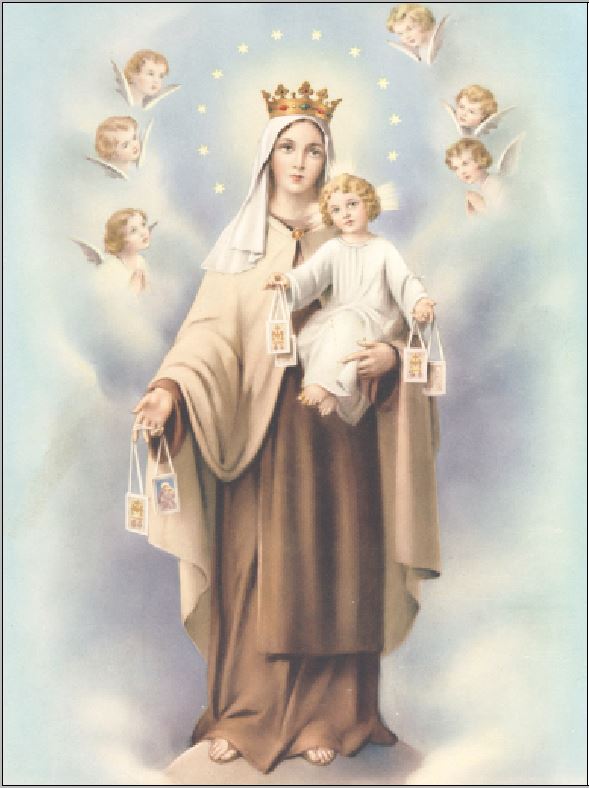 by Dom Antoine Marie, O.S.B.
by Dom Antoine Marie, O.S.B.
From May 13 to October 13, 1917, the Blessed Virgin Mary appeared seven times to three young Portuguese shepherds in Fatima, Portugal. In her last appearance, the Mother of God was holding two squares of brown wool cloth connected by cords: a Scapular of Mount Carmel. In August of 1950, Sister Lucia, one of the three seers who later became a Carmelite nun, explained that it was: “Because Our Lady wants all to wear the Scapular.” What, then, is the origin of this “habit” presented by Mary?
The prophets of old sang of the beauty of Mount Carmel, the promontory mountain of Galilee, jutting out over the Mediterranean. In the ninth century, before the incarnation of the Son of God, the prophet Elijah identified Carmel with its virtues and its miracles. Towards the 1st century A.D., there were Byzantine monasteries upon whose later ruins would be grouped hermits from Europe who had come to Palestine during the great movement of the Crusades at the end of the twelfth century. They would construct a small church on Mount Carmel dedicated to Our Lady, where the Mother of God would be named, “Princess and Mother of Carmel.” Then, in the thirteenth century, these monks would be driven from the Holy Land by Islamic persecution and forced to return to Europe. Thus, the origins of the religious of Our Lady of Mount Carmel, or the Carmelites as they became known thereafter.
Saint Simon Stock was born in England at the end of the twelfth century and was witness to the beginnings of the Order of Carmelites on Mount Carmel. When he returned to England in the mid-thirteenth century, he was elected Prior General of the Order. During this time, there were many Carmelite religious who were going over to other mendicant orders, such as the Franciscans and Dominicans, threatening the very existence of the Order. Entreatingly, Saint Simon Stock turned in prayer to Mary, and the Mother of God responded by appearing to him on July 16, 1251. Here is what is related in an ancient document: “St. Simon was an Englishman, a man of great holiness and devotion, who always in his prayers asked the Virgin to favor his Order with some singular privilege. The Virgin appeared to him, surrounded by a multitude of angels, and holding the Scapular in her hand. (The scapular was a type of work apron, frequently used by monks, consisting of large pieces of cloth in front and back, joined over the shoulders with strips of cloth.) Our Lady said to him, ‘This is for you and yours, a privilege; whosoever dies clothed in this Scapular shall not suffer eternal fire.’” The vision was soon recognized by Pope Innocent IV, and the news of this wonderful gift of the Mother of God to the Carmelite Order spread rapidly. People from all over and from every walk of life came in great haste, eager to be among those favored with this promise: in fact, the gift of the Scapular had been made to the entire Church, for Our Lady had said “whosoever dies clothed in this Scapular...” In becoming members of the Scapular Confraternity, the laity were able to benefit from this message of salvation given to the Carmelites. The Scapular was then reduced in size so that the “habit” of Carmel could also be discreetly worn by the laity.
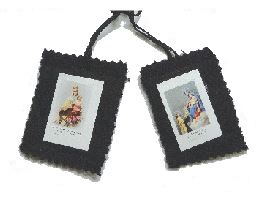 The blessings accorded by Mary to the Scapular should conduce the faithful to ponder on the question of eternal salvation; to realize that our life on earth will one day end and that we will be judged by God at our death according to what we have done with our life. In the Catechism of the Catholic Church we read, “What is the particular judgment?” The answer being that: “Each man receives his eternal retribution in his immortal soul at the very moment of his death, in a particular judgment that refers his life to Christ: either entrance into the blessedness of heaven – through a purification or immediately – or immediate and everlasting damnation.” (n.1022). This truth about the last end of man is of vital importance; it is our conduct in this life which prepares us for our eternity. To deny these revealed truths does not render them obsolete or change their veracity.
The blessings accorded by Mary to the Scapular should conduce the faithful to ponder on the question of eternal salvation; to realize that our life on earth will one day end and that we will be judged by God at our death according to what we have done with our life. In the Catechism of the Catholic Church we read, “What is the particular judgment?” The answer being that: “Each man receives his eternal retribution in his immortal soul at the very moment of his death, in a particular judgment that refers his life to Christ: either entrance into the blessedness of heaven – through a purification or immediately – or immediate and everlasting damnation.” (n.1022). This truth about the last end of man is of vital importance; it is our conduct in this life which prepares us for our eternity. To deny these revealed truths does not render them obsolete or change their veracity.
In fact, Our Lord when preaching often referred to the issue of eternal life. He emphasized the foolishness of risking eternity for goods that do not last: “For what will it profit a man if he gains the whole world and forfeits his soul?” (Matt 16:26). “Enter through the narrow gate; for the gate is wide and the way is broad that leads to destruction, and there are many who enter through it.” (Matt 7:13-14). Jesus often speaks of the “hell fire that is not quenched” (Matt 5, 22, 29-30), “And fear ye not them that kill the body, and are not able to kill the soul: but rather fear him that can destroy both soul and body in hell.” (Matt 10:28). He solemnly proclaims that we are separated from him if we fail to take care of the serious needs of the poor and the little ones who are his brothers (Matt 25, 31-46). In still other places He warns us that we cannot know when He will ask us to be accountable for our actions, “Therefore be on the alert, for you do not know which day your Lord is coming…for the Son of Man is coming at an hour when you do not think He will” (Mt 24:42-44). St. Alphonsus liked to repeat this quote from St. Eucherius, bishop of Lyon, “The worst error is to ignore the importance of eternal salvation.”
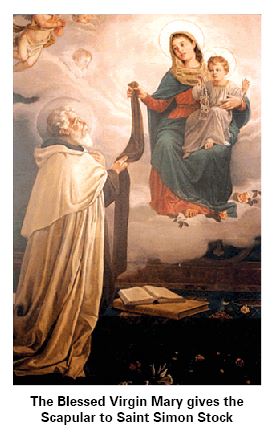 The first degree
The first degreeFrom the Prologue of his Rule, St. Benedict turns the gaze of his monks to these important truths: “We must therefore obey (God) at all times, aided by the goodness which He has placed inside each of us. Not only to prevent the anger of the Father from one day disinheriting his children, but even more so, that the dreaded Master, provoked by our evil deeds, does not condemn us to eternal punishment as very wicked servants, unwilling to follow Him unto His glory.” And in his chapter on humility, the saint says, “The first degree of humility is the fear of God, which a monk must keep constantly before his eyes, never to forget it. He must always remember everything that God has commanded, and often remind himself of the hell into which, because of their sins, fall those who despise Him, and that eternal life is prepared for those who fear Him.”
This is why the Second Vatican Council addresses the faithful with this exhortation: “Since however we know not the day nor the hour, on Our Lord’s advice we must be constantly vigilant so that, having finished the course of our earthly life, we may merit to enter into the marriage feast with Him and to be numbered among the blessed, and that we may not be ordered to go into eternal fire like the wicked and slothful servant, into the exterior darkness where ‘there will be the weeping and the gnashing of teeth’” (Lumen Gentium, 48). The path that leads to eternal life is, first, that of faith: “Go into all the world,” Jesus commands his disciples, “and proclaim the gospel to the whole creation. Whoever believes and is baptized will be saved, but whoever does not believe will be condemned” (Mk 16: 15-16).
But true faith results in good works, and by first keeping the Commandments of God: Someone came to Jesus and said to him, “Good master, what good shall I do that I may have life everlasting?” Jesus said to him, “Why asketh thou me concerning good? One is good, God. But if thou wilt enter into life, keep the Commandments.” He said to him: “Which?” And Jesus said: “Thou shalt do no murder, Thou shalt not commit adultery, Thou shalt not steal, Thou shalt not bear false witness. Honor thy father and thy mother: and, Thou shalt love thy neighbor as thyself” (Matt 19:16-19). Conversely, bad deeds lead to hell. Saint Paul reminds us: “Or do you not know that the unrighteous will not inherit the Kingdom of God? Do not be deceived: neither the sexually immoral, nor idolaters, nor adulterers, nor men who practice homosexuality, nor thieves, nor the greedy, nor drunkards, nor revilers, nor swindlers will inherit the Kingdom of God” (1 Cor 6:9-10).
On August 6, 1950, Pope Pius XII said: “How many souls, from the circumstances of human despair, owe their final conversion and their eternal salvation to the Scapular in which they were clothed! How many also, in danger of body or soul, are saved by the grace of the maternal protection of Mary.” Ancient narratives report that the first miracle of the Scapular was the deathbed conversion of an English nobleman who had scandalized the whole region. Saint Simon Stock obtained this miracle by laying his Scapular over the dying man. He then saw in this miracle an incentive to reveal the secret of the precious garment, received from the hand of Mary, to his brothers. Countless saints and famous people have worn the Scapular, e.g. Saints Robert Bellarmine, Charles Borromeo, Alphonsus Liguori, John Bosco, Bernadette Soubirous, as well as most of the Popes of the last three centuries, especially Pope St. John Paul II.
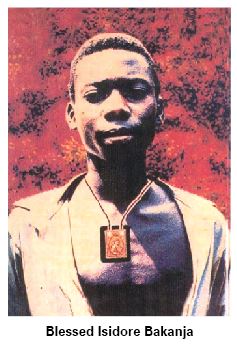 Natural moral law
Natural moral lawIn the early twentieth century, there was a young African man who faithfully wore the Scapular of Mount Carmel right up until his bloody martyrdom. Bakanja was born in 1885, in Bokendela, in what is now the Democratic Republic of Congo. His father, Iyonzwa, came from a family of farmers, and his mother Inyuka’s family made their living from fishing. Bakanja had one older brother and a younger sister. Though they were pagans, the family honored the best of African traditions in their practice of natural moral values: Iyonzwa did not practice polygamy, and Bakanja showed an exemplary obedience to his parents… Later on, when his executioner, in an attempt to justify his violence against the young man, accused Bakanja of stealing bottles of wine, all the witnesses cried out against the slanderer in defense of the young man, for never had it happened that Bakanja had been caught committing even the smallest of thefts.
At the time of Bakanja’s birth, the Berlin Conference had just recognized the sovereignty of the Belgian King, Leopold II, in what later became known as the Congo Free State. As a result, the region saw an influx of missionaries, but also many adventure seekers who came looking to “get rich quick”. Consequently, various developers took control of the wealth of the Congo Basin, which included rubber and ivory and, on behalf of the king, forwarded it to the Atlantic Coast. The local people were coerced into providing the cheap labor. Not unlike other young people of his village, Bakanja’s dream was to go work in Mbandaka, a city not far to the south. Shortly after he came of age, Bakanja went down the river to Mbandaka and was hired as a brick mason. It was there that he met the Trappist monks (Cistercians) from the mission of Bolokwa-Nsimba, and learned, with great amazement, the blessings and beauty of the Christian Faith. He was impressed with the hospitality, kindness and dedication of the missionaries to the poor and sick, and asked them for Baptism. The Trappist Fathers instructed him in the Faith, and on May 6, 1906, he was baptized in the parish of St. Eugene at Bolokwa-Nsimba, and given the name of Isidore. That same day, he was clothed with the Scapular of Mount Carmel. On November 25, he received Confirmation and on August 8, 1907, according to the customs of the time, he made his First Holy Communion. Isidore had a great devotion to the Rosary and to the Scapular, and carried them with him at all times because he wished to be a witness to his faith. He was an apostle to his friends and fellow workers, and drew them to the Christian Faith by his words and example.
When his employment contract had expired, Isidore returned to his village. His father, upon seeing him, asked what he had done with the charms that had been given to him before his departure. Isidore responded calmly that he no longer carried the charms because he now had a much more effective protection: Jesus Christ, the Son of God, and the Virgin Mary. Despite the warnings of his friends who feared the Europeans, Isidore accepted a position as a servant in Busira at the house of a plantation supervisor named Reynders. Reynders was a member of the S.A.B. (Société Anonyme Belge), which exploited the rubber and ivory. Isidore was soon recognized as an exemplary and conscientious worker. Many were impressed by his wisdom, and chose him as their catechist. When Reynders was transferred to Ikili, he opted to bring Isidore with him. He had come to appreciate Isidore’s personal qualities. The local manager of the S.A.B. in Ikili, Van Cauter, was known for his harshness and his fierce opposition to Christianity and to Christian missionaries, so Reynders urged Isidore to conceal his Christian Faith in order to avoid any trouble. Isidore, however, was the only Christian in Iliki. He could not keep to himself the new joy that he was now living in knowing Christ. Van Cauter soon discovered this and forbade Isidore to teach prayer to his fellow workers.
On February 1, 1909, while serving at table, Isidore was rudely ordered by Van Cauter to remove his Scapular. To this the young man replied, “Master, you demand that I remove the habit of the Blessed Virgin. I will not do it. As a Christian, I have the right to wear the Scapular.” Furious, the plantation manager ordered twenty-five lashes with the “chicotte”, a leather whip. Isidore accepted with angelic patience this unjust punishment, uniting himself in spirit to Jesus in his Passion. A later investigation proved that Isidore’s case was far from being an isolated one: a veritable persecution had been organized against the Catholic missions by officials of the S.A.B. The watchword was to prohibit, at all cost, African employees from carrying with them a Scapular or a Rosary.
Shortly afterwards, Van Cauter ordered Isidore to stop spreading “the garbage learned from the Fathers”, saying: “I do not want Christians here! Is that understood?” Then, snatching the Scapular from around the neck of the young man, he threw it to his dog. He then went himself to get a “chicotte” made from strips of elephant skin, with two nails attached to the ends of each strip. Van Cauter ordered Isidore to be beaten until he bled. At first, the employees would not obey, not even under the threat of punishment. Eventually though, they gave in and whipped Isidore while Van Cauter, himself, was kicking him. Despite this, the young Christian continued to show his faith freely and openly. He would withdraw to pray the Rosary and meditate alone or in the company of those workers who wanted to learn the catechism. One day during his break, Van Cauter saw Isidore in an attitude of prayer. Furious, he ordered him lashed on the spot. This whip was made of hippopotamus skin and trimmed with sharp nails. Isidore received so many blows that it tore away his skin and dug into his flesh. During the beatification process in 1913, witnesses spoke of at least two hundred blows that he received. Unconscious, he was then taken to a prison where he remained for four days without care or food, and his feet were clamped together with metal cuffs connected to an enormous weight.
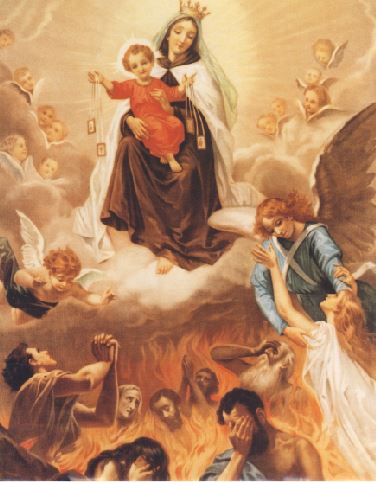 The Blessed Virgin promised the Holy Father to grant the release from Purgatory, on the first Saturday after their death, of all those who would faithfully wear her Scapular during their lifetime. The Blessed Virgin promised the Holy Father to grant the release from Purgatory, on the first Saturday after their death, of all those who would faithfully wear her Scapular during their lifetime. |
When the news of the arrival of an inspector of the S.A.B. reached Ikili, Van Cauter panicked. He transferred Isidore to Isako to hide him from the inspector. Isidore somehow managed to escape his tormentor and was aided by an African who brought him back to his home village. A German geologist, Dr. Drpinghaus, employed by the S.A.B., discovered Isidore and attempted to heal him. Isidore’s whole body was one entire wound; his bones were laid bare and caused him great suffering. “I saw a man,” testified Drpinghaus, “whose back was literally ‘plowed’ with deep wounds ... with the help of two sticks, he approached me, crawling rather than walking. I asked the poor man: ‘What have you done to deserve such a punishment?’ He told me that he was a catechist of the Catholic mission of the Trappist’s in Bamanya and that he had wanted to convert the factory workers. For that reason, the white man had had him flogged with a heavy whip trimmed with sharp nails.”
The infection by this time had become irreversible; sepsis had set in. Isidore was taken to the home of a cousin in Busira so that he could be taken care of there. On July 24 and 25, two Trappist Fathers came to administer to him the last sacraments: Confession, Communion and the Anointing of the Sick. Isidore forgave his executioners and prayed for them. “Father,” he told one of the missionaries, “I am not angry. The white man struck me, that is his business. He must know what he is doing. Of course, in Heaven, I will pray for him.” On August 15, the local Christians all gathered in front of the house where he lay dying; Isidore was radiant with joy to be united with the community to praise Mary in the mystery of her Assumption into Heaven. To the astonishment of all, he got up from his bed, took a few steps, in silence, Rosary in hand; then he lay back down, entered into his agony and breathed his last, with his Scapular around his neck.
On June 7, 1917, his remains were transported to the parish church of the Immaculate Conception of Bokote. On April 24, 1994, during the Special Assembly of the Synod of Bishops in Africa, Pope John Paul II beatified Isidore Bakanja, and in 1999 proclaimed him Patron of the Laity of the Democratic Republic of Congo.
Among the many spiritual favors granted to those who wear the Scapular, the “Sabbatine Privilege” is the most prominent. Its origin is the “Sabbatine Bull” given by Pope John XXII in 1317, after having been favored with a vision of the Blessed Queen of Carmel. The Blessed Virgin promised the Holy Father to grant the release from Purgatory, on the first Saturday after their death, of all those who would faithfully wear her Scapular during their lifetime.
Two conditions were set in order to benefit from this new promise: that members of the Scapular Confraternity practice chastity in their state in life (complete chastity in celibacy and conjugal chastity in marriage), and that members also recite the breviary (or Little Office of the Blessed Virgin). When enrolling members with the Scapular, priests have the authority to lessen this obligation, as the recitation of the breviary may prove a little difficult for some, to reciting the Rosary, for example, in its place. The authority of the Church has repeatedly confirmed, in the most formal manner, the content of this Bull, namely the “Sabbatine Privilege.” Few indulgences have received as many and as solemn a papal approval.
St. John of the Cross, on the eve of his death, a Friday, remembered with pleasure “How on Saturdays, the Mother of God of Mount Carmel came in haste to Purgatory with her help and her support, and how she delivered those religious and those souls who had faithfully worn her holy Scapular.” It must be said that the Scapular is not a “guaranteed salvation” which dispenses one from needing to strive towards sanctity and/or obeying the Commandments of God. As if the sinner, after receiving the Scapular could indulge in all kinds of sin in perfect safety by saying: “Since I wear the Scapular, I’m sure not to be damned.” He who misuses this devotion to the Blessed Virgin would be unworthy of any of her favors. Rest assured that it would be very wrong to abuse of this privilege of the Scapular because, God is not mocked (Galatians 6:7). In her desire to see her children achieve the happiness of Heaven, Our Lady has given them the gift of the Scapular as a garment of salvation, a spiritual armor and shield, a robe of innocence, in which she clothes them to help them live without sin and to follow Jesus under the guidance of the Holy Spirit.
The Scapular represents a consecration and a voluntary “gift of one’s self” to Mary: “Through the Scapular,” said Saint John Paul II, “the devotees of Our Lady of Carmel express their desire to model their lives on the example of Mary, Mother, Patroness, Sister, the most pure Virgin, welcoming with a purified heart the Word of God and devoting one’s self with zeal to the service of others “(L’Osservatore Romano, July 26, 1988). In return, Our Lady is committed to protecting the one who wears this “habit” at all times, but most especially, at the hour of death. Let us entrust ourselves completely to Mary, who will preserve us in the love of God and our neighbor.
Dom Antoine Marie, O.S.B.
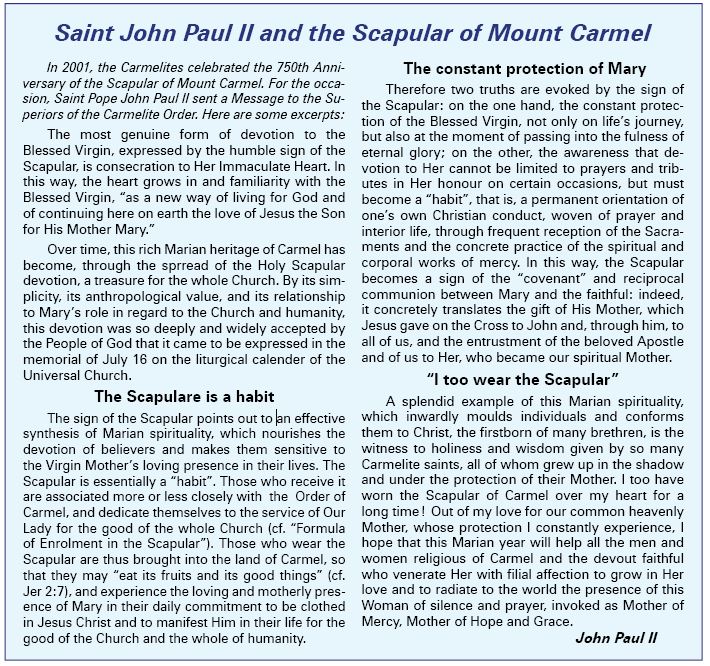
This article is reprinted with permission from the Abbey of Clairval, France, which publishes every month a spiritual newsletter on the life of a saint in English, French, Italian, or Dutch. Their postal address: Dom Antoine Marie, Abbe, Abbaye Saint-Joseph de Clairval 21150 Flavigny sur Ozerain,France. Their website: http:// www.clairval.com.